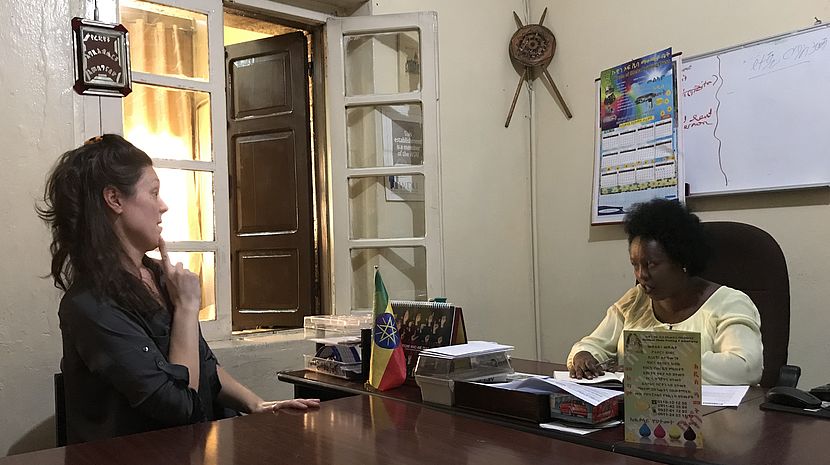31.10.2019 Measuring the implementation of the Sustainable Development Goals

©CBM
The 10th IAEG-SDGs meeting on the global SDG indicator framework concluded last week in Addis Ababa, Ethiopia. The key areas discussed were the 2020 Comprehensive Review, data disaggregation and country examples of SDG implementation. In addition, new members were elected to the IAEG and participated: Afghanistan, Dominican Republic, Ireland, Japan, Kyrgyz Republic, Libya, Malawi, Malaysia, Niger, and Oman.
Complementing citizen-gathered data with official statistics, especially at the local level was a common thread throughout the discussions and disability data was included many times as examples of data being collected and where gaps remain. For example, Italy and Ethiopia highlighted disability in their country examples of SDG implementation: Italy highlighted that they are collecting disability data and Ethiopia has coordinated with stakeholders in SDG implementation, including youth, women, persons with disabilities, and the private sector.
The disaggregation work stream jump started after a yearlong pause due to work on the 2020 Comprehensive Review. It will shift from policy to a crosscutting approach integrating data sources, including civil society data as best practices. This group will be the focus of the IAEG henceforth in a mainstreamed manner. This is a key space for us to engage and provide our advances in producing data disaggregated by disability. Accessibility for persons with disabilities, such as accessible transportation is not addressed and is an area that needs to be developed.
The focus of this meeting was the 2020 comprehensive review with proposals for revision, replacement, additions and deletions to the global indicator framework. Below, the relevant indicators for persons with disabilities are highlighted:
Proposed additional indicators:
Only 6 of the 16 proposed additional indicators were preliminary agreed by the IAEG. The discussions over the 2020 comprehensive review have concluded and more than likely the indicators not considered agreed will be dropped. The relevant ones include:
- Under Target 3.4 with WHO as the proposed custodian agency: Proportion of persons with a severe mental disorder (psychosis, bipolar affective disorder, or moderate-severe depression) who are using services
- Under Target 8.5 (in addition to indicators 8.5.1 and 8.5.2) with ILO as the proposed custodian agency: Employment-to-population ratio by sex, age and disability status
Proposed indicator deletions:
- Indicator 17.18.1: Proportion of sustainable development indicators produced at the national level with full disaggregation when relevant to the target, in accordance with the Fundamental Principles of Official Statistics was put forward to be deleted but due to strong push back, it will remain in the global framework with modifications. This indicator includes disability disaggregation.
Indicator refinements:
- 4.a.1 will change from: Proportion of schools with access to (a) electricity; (b) the Internet for pedagogical purposes; (c) computers for pedagogical purposes; (d) adapted infrastructure and materials for students with disabilities; (e) basic drinking water; (f) single-sex basic sanitation facilities; and (g) basic handwashing facilities (as per the WASH indicator definitions) to: Proportion of schools offering basic services, by type of service the language changes. The indicator has been shortened for convenience, but the metadata for all groups, including for students with disabilities will continue to be collected.
- 8.5.1 will change from: Average hourly earnings of female and male employees, by occupation, age and persons with disabilities to: Average hourly earnings of employees, by sex, age occupation and persons with disabilities.
As CBM and the Stakeholder Group of Persons with Disabilities, we were very active and presented a total of four times, including:
- In the Stakeholder Briefing on behalf of stakeholders calling for a stakeholder side event at the 51st session of the Statistical Commission;
- At the data disaggregation side event on two best practices, including the Washington Group review on which data on SDG indicators currently available can be disaggregated by disability status and the CBM and Fundación Vision, Paraguay project on disability disaggregated data collection in an eye hospital in Paraguay;
- As an official panelist on the disability data advocacy working group’s advances in producing data disaggregated by disability; and
- As an official panelist as CBM on the International Civil Society Centre’s Leave No One Behind Partnership on inclusive SDG implementation that addresses the needs of marginalized groups effectively, including persons with disabilities.
Next Steps
The outcome of the 2020 comprehensive review at the meeting will result in a proposal that goes to the 51st UN Statistical Commission in March with some additions, deletions, and modifications. The focus now will turn to implementation with the main objectives of the IAEG to create better tools for monitoring the SDGs, data production at the national level, use new data sources, and improve financing for data and statistics. With a focus on gathering data better, improving the data that exists, and focus on the LNOB principle on data disaggregation. Due to this shift, there will only be one IAEG meeting next year.